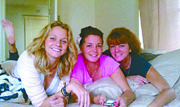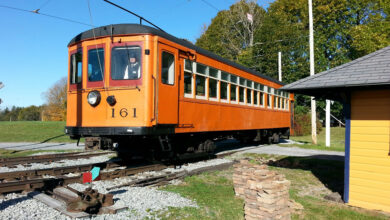A precious gift: Live kidney donation aids another’s quality of life
by Kristina Gabalski
 L to r: Mackenzie, Chelsey and Laurie LoMonaco.Gift giving is a big part of the holidays, but Laurie LoMonaco of Brockport has spent 2012 preparing to give a very precious gift: a better and longer life for someone else.
L to r: Mackenzie, Chelsey and Laurie LoMonaco.Gift giving is a big part of the holidays, but Laurie LoMonaco of Brockport has spent 2012 preparing to give a very precious gift: a better and longer life for someone else.
On January 23, 2013, Laurie is tentatively scheduled to donate her left kidney to a recipient who has been on dialysis for some time and would likely have spent four to five years on a waiting list for a transplant.
The process which brought Laurie to this point has been a long one.
Laurie says it was more than two years ago that she began researching live kidney donation, including speaking with other live donors.
“It was January of 2012 that I just woke up one day and decided to get the ball rolling,” Laurie recalls.
She contacted the National Kidney Registry (NKR) through which she wanted to make the altruistic donation.
Medical testing commenced in February with a full blood panel, urine collection, “and my primary physician even needed to sign-off that I am of sound mind,” Laurie says.
Through a medical board, NKR then cleared Laurie to proceed with more required tests.
Laurie says she initially was not interested in knowing the recipient, but someone mentioned to her a potential recipient whom Laurie had met once ten years ago.
She talked with him and after more blood work at Strong Hospital, the two were found to be compatible.
During July, Laurie spent two full days at Strong for a barrage of tests including pulmonary, CAT scans, EKG, chest X-rays, a stress test and Glo-fil testing to see how well her blood filtered radioactive iodine.
Laurie also met with people on her donor team including a dietician, social worker, donor coordinators, a nephrologist and her surgeon, Dr. Carlos Marroquin.
The testing is rigid and exhausting, Laurie says, “But it has to be in order to be certain that a donor’s body can physically withstand the surgery. Meeting with the social worker and others on my donor ‘team’ is also to be sure I can mentally withstand the surgery.
“I think it’s important to note,” Laurie says, “that when I initially was speaking with Strong about becoming a donor for this particular recipient, Strong was not affiliated with the National Kidney Registry. I’m so happy to say they now are, and that gives access to so many others in the central and Western New York area for a paired donation and to become part of the kidney ‘chain’.”
Laurie says several factors played a roll in her decision to go head with the donation, including the fact she has a universal blood type and tends to bounce back well from surgery.
“Being able to give of yourself is important,” she says. “When I am long gone, I hope it is something that both my daughters will remember about me. I’ve never questioned this decision.”
Learning about the process
Laurie explains that she alleviated the initial concerns of her children by educating them about the process.
Her daughter, Chelsey, says she was concerned at first, “but then I really took the time to think about it and how selfless it is. Someone out there is going to have a much better and longer life because of my mom, and that makes me so proud to be her daughter.”
The support she has received has been nothing less than positive, Laurie says. She will need the assistance of family and friends for several weeks following surgery and has assembled a support team to help with daily tasks like walking her dogs.
“This surgery wouldn’t be happening without two tremendous daughters and a litany of friends and family who will be with me through the entire process. There is no way I could even begin to thank my friends and family, who mean so much, for supporting me,” she says. “If sharing this story educates others about the live donation process and if just one other person steps up and says ‘I can do that too,’ then I’m okay with throwing my privacy to the wind. Even better: if Strong and the National Kidney Registry are bombarded with phone calls about people wanting to become a live donor.”
Laurie is keeping a journal to keep track of everything about the process, she adds. “It definitely helps to be able to write and sort out thoughts,” she says.
The surgery initially was scheduled for October 2012, but has been delayed twice.
The first time was because of Laurie’s work schedule and the second time, in November, was because of issues with the recipient’s pre-operative blood work.
Even with surgery re-scheduled for January 23, there is still the possibility of another delay, Laurie says.
She expects to do just fine with one kidney once the surgery is over.
The live donor is always left with the better of the two kidneys, Laurie explains.
“Everyone knows there is risk with every surgery. That being said, there is every reason to believe that I will function normally and be fine with one kidney. In my research, I’ve found studies that conclude that live donors live longer and physically healthier lives than non-donors with two functioning kidneys.”
Daughter Chelsey says if someone is capable of taking time off of work, is very healthy, and has the support of family and friends, she would encourage them to consider being a live kidney donor. She notes it’s not for everyone. “To be honest,” she says, “I don’t think it’s something I could do. It’s for special people, and my mom is most definitely special.”
Laurie enthusiastically encourages others to consider being a donor.
“I don’t see me not advocating live donation of any organ, particularly a live kidney donation,” she says. “The incentive is to improve the quality of someone’s life, maybe even save a life. What more incentive is needed?”




